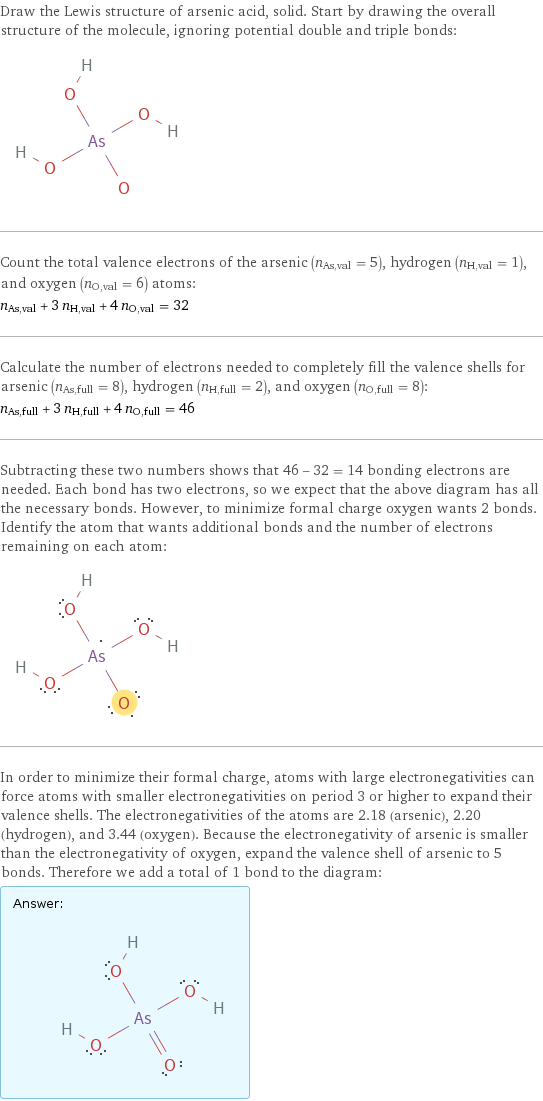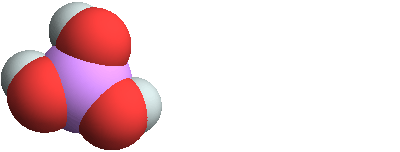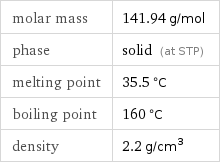Input interpretation

arsenic acid, solid
Chemical names and formulas

formula | H_3AsO_4 Hill formula | AsH_3O_4 name | arsenic acid, solid IUPAC name | arsoric acid alternate names | arsenate | arsenic acid | orthoarsenic acid | orthoarsenic acid hemihydrate mass fractions | As (arsenic) 52.8% | H (hydrogen) 2.13% | O (oxygen) 45.1%
Lewis structure

Draw the Lewis structure of arsenic acid, solid. Start by drawing the overall structure of the molecule, ignoring potential double and triple bonds: Count the total valence electrons of the arsenic (n_As, val = 5), hydrogen (n_H, val = 1), and oxygen (n_O, val = 6) atoms: n_As, val + 3 n_H, val + 4 n_O, val = 32 Calculate the number of electrons needed to completely fill the valence shells for arsenic (n_As, full = 8), hydrogen (n_H, full = 2), and oxygen (n_O, full = 8): n_As, full + 3 n_H, full + 4 n_O, full = 46 Subtracting these two numbers shows that 46 - 32 = 14 bonding electrons are needed. Each bond has two electrons, so we expect that the above diagram has all the necessary bonds. However, to minimize formal charge oxygen wants 2 bonds. Identify the atom that wants additional bonds and the number of electrons remaining on each atom: In order to minimize their formal charge, atoms with large electronegativities can force atoms with smaller electronegativities on period 3 or higher to expand their valence shells. The electronegativities of the atoms are 2.18 (arsenic), 2.20 (hydrogen), and 3.44 (oxygen). Because the electronegativity of arsenic is smaller than the electronegativity of oxygen, expand the valence shell of arsenic to 5 bonds. Therefore we add a total of 1 bond to the diagram: Answer: | |
3D structure

3D structure
Basic properties

molar mass | 141.94 g/mol phase | solid (at STP) melting point | 35.5 °C boiling point | 160 °C density | 2.2 g/cm^3
Units

Solid properties (at STP)

density | 2.2 g/cm^3
Units

Thermodynamic properties

specific heat of formation Δ_fH° | solid | -6.385 kJ/g molar heat of formation Δ_fH° | solid | -906.3 kJ/mol (at STP)
Chemical identifiers
(O)O InChI identifier | InChI=1/AsH3O4/c2-1(3, 4)5/h(H3, 2, 3, 4, 5)/f/h2-4H EU number | 231-901-9 Gmelin number | 2294 RTECS number | CG0700000 NSC number | 309958](../image_source/1bdcfc03ecdfe7af6946b58cbc4b6335.png)
CAS number | 7778-39-4 PubChem CID number | 234 SMILES identifier | O[As](=O)(O)O InChI identifier | InChI=1/AsH3O4/c2-1(3, 4)5/h(H3, 2, 3, 4, 5)/f/h2-4H EU number | 231-901-9 Gmelin number | 2294 RTECS number | CG0700000 NSC number | 309958
NFPA label

NFPA label

NFPA health rating | 3
Toxicity properties

RTECS classes | agricultural chemical and pesticide | mutagen | reproductive effector
Ion equivalents

(AsO_4)^(3-) (arsenate anion) | 1 H^+ (hydrogen cation) | 3